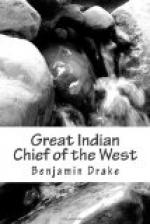“As soon as it was ascertained that the Indians had retired from the neighborhood, the inhabitants proceeded to gather the dead, that lay scattered in all parts of the prairie. Seven were at first found and buried in one grave. Ten or twelve others, in the course of a fortnight, were discovered in the long grass that bordered the marshes. The acts of the Indians were accompanied by their characteristic ferocity. Some of their victims were horribly mangled. With the exception of one individual, the whites who accompanied the Indians, did not take part in the butcheries that were committed. A young man by the name of Calve, was found dead, his skull split open, and a tomahawk, on the blade of which was written the word Calve, sticking in his brain. He was supposed to have fallen by the hand of his uncle. Had those who discovered the Indians in the prairie, fled to the lower gate, they would have escaped; but the greater part of them took the road that led to the upper gate, through the very ranks of the enemy, and were thus exposed to the whole of their fire. About twenty persons, it is computed, met their death in endeavoring to get within the entrenchments. None of those within were injured, and none of the Indians were killed, at least none of them were found. Their object was not plunder, for they did not attempt, in their retreat, to take away with them any of the cattle or the horses that were in the prairie, and that they might have taken; nor did they attack any of the neighboring towns, where danger would have been less, and the prospect of success greater. The only object they had in view was the destruction of St. Louis; and this would seem to favor the idea that they were instigated by the English, and gives good ground, when connected with other circumstances, to believe that Leyba was their aider and abettor. * * * *




